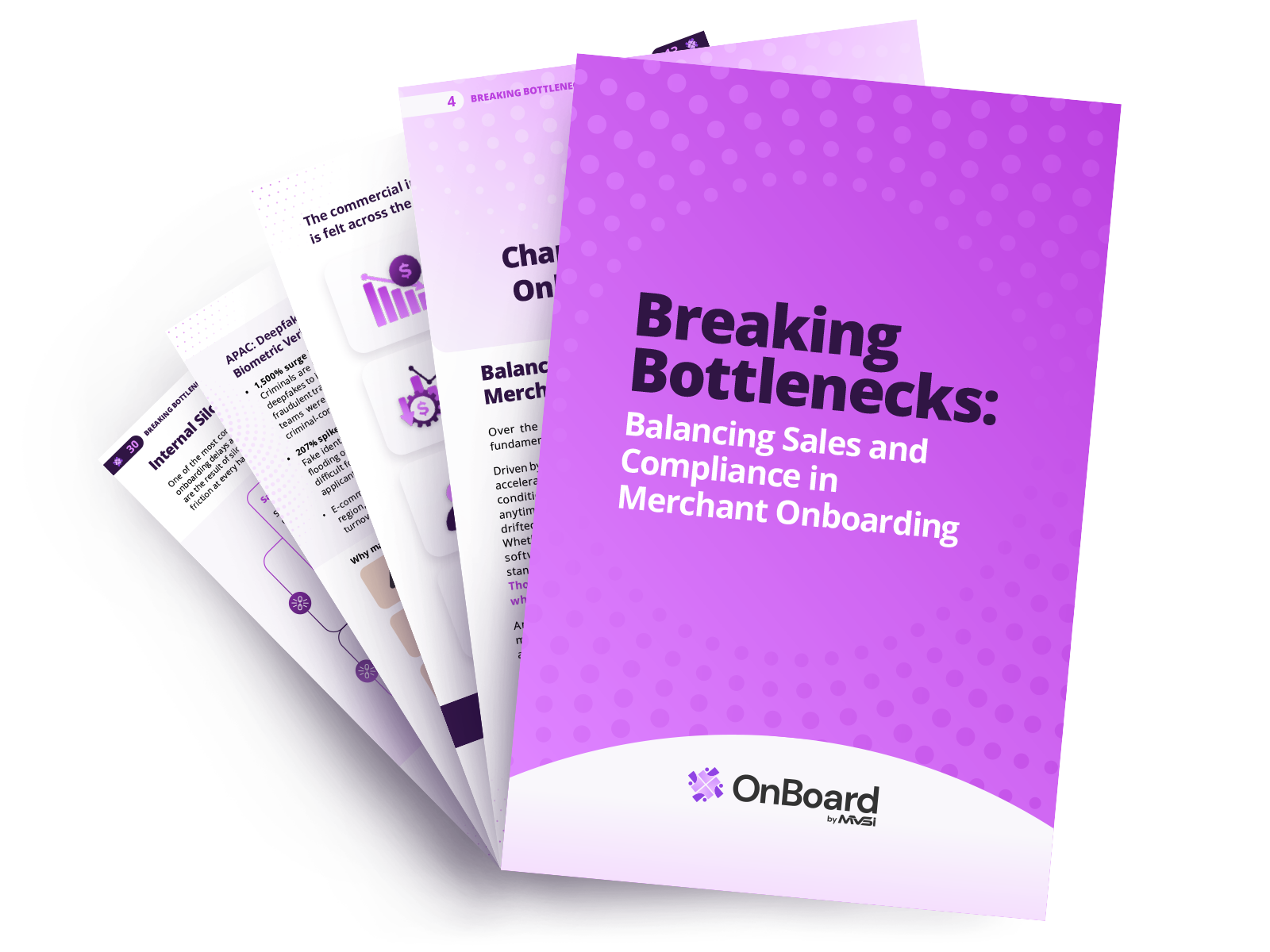This article explores the ongoing struggle between speed and compliance in merchant onboarding, how manual processes create costly jams, and how digital onboarding solutions enable streamlined growth without sacrificing safety.
Key Takeaways
- The trade-off between speed and compliance is a myth. Manual processes make it feel real, but modern onboarding with the right technology can deliver both without compromise.
- The biggest jams come from paperwork and silos. Documentation overload and fragmented workflows waste time, suffocate teams, and drive merchants away.
- Management by exception unlocks true efficiency. Low-risk merchants move through quickly, while compliance experts focus on complex ownership, fraud, and nuanced risk.
- Streamlined merchant onboarding pays off. Providers see higher conversion, stronger loyalty, and proven revenue growth.
Speed vs Safety: The False Trade-Off in Merchant Onboarding
The battle between speed and compliance is not a perception.
It is the reality. We see it every day.
Providers push for faster onboarding to win merchants, while regulators demand tighter compliance. Very few organisations are satisfied with both at the same time.
This ongoing trade-off has become the norm, but it does not have to stay that way. If speed and compliance keep being treated as opposing forces, nothing will ever change. Payment providers must now ask themselves a harder question: what will you do next?
The market has moved on while many merchant onboarding processes are still stuck in the past. Conceding on speed doesn't just mildly irritate customers anymore, it bleeds revenue. Those lost merchants are not just statistics. They are your product rolling off the end of the line faulty, straight into the scrap bin. The data paints a brutal picture: one survey found a staggering 90% of companies lose potential customers during digital onboarding due to lengthy, manual processes. These aren't just lost prospects; they represent institutional failure on an industrial scale.
Every delay carries a cost beyond the immediate lost deal. Poor onboarding accelerates churn, cutting merchant lifetime value from three or four years down to as little as one. PwC data confirms that 8% of customers leave after a single bad experience and more than half after several. You are not only losing today’s deals. You are cutting off future revenue from more than half your merchant base.
Modern merchants vote with their feet, and they're walking toward providers who understand that speed isn't a luxury, it's table stakes. A Mastercard survey reveals that 30–35% of merchants now cite fast, simple onboarding as a top factor in choosing a payments provider. They're not politely asking for better service; they're demanding it as the cost of doing business.
The competitive pressure has never been more intense.
Traditional banks, with onboarding cycles that drag on for 3–7 days, are watching payment facilitators steal merchants by completing the same process in minutes. That is not a gap. It is a gulf. The true benchmark should be the same day to two days, a standard entirely achievable with today’s orchestration and decisioning technology. But reckless speed is not the answer. Compliance rules are tighter than ever. Safety is not optional.
This is why we see the so-called “speed versus compliance” debate as a false choice. If you are still relying on manual processes, the trade-off feels real, but it is killing your business. The old playbook is not only inefficient, it is obsolete. Now is the time to replace it with one where speed and security work together.
Where the Line Jams
If onboarding is an assembly line, the breakdowns are predictable. They rarely come from dramatic explosions or single catastrophic failures. More often, it is the slow grind of inefficiency building up until the line stalls. The problem is not one missing part. It is a series of clogged stations where teams are drowning in documentation. It is death by a thousand paper cuts.
The single biggest bottleneck is documentation. Complex ownership structures such as trusts, partnerships and multi-layered entities create a mountain of paperwork. Every page has to be read, checked, and verified. This is not a simple data entry job. It is a forensic review, and it slows entire workflows to a crawl.
Intake is where the first major jam occurs. This is where manual handoffs between siloed departments—from sales to compliance to underwriting—create delay and invite error. Information moves through the organisation like a paper memo in a digital age, requiring manual transcription at every stage. Research from ABBYY confirms this systemic pain: nine in ten companies experience customer drop-offs during onboarding. This is not a minor inconvenience. For your customers, every delay feels like resistance, and eventually patience runs out. They leave the process unfinished, taking their business with them.
We know better than anyone that compliance is where the process so often collapses. Manual checks carried out in silos miss the patterns that reveal sophisticated fraud. What should be vigilance turns into vulnerability, and you feel that weight every day.
This is not only inefficient. It is expensive. Attrition during merchant onboarding can reach up to 20 percent, which means one in five merchants are lost before they ever process a single transaction. Think about what that really means. You have already paid the cost of acquisition, invested sales time, and fought for market share, only to watch those hard-won merchants walk away. The impact on growth is brutal. Sales productivity drops, acquisition costs rise, and the return on investment disappears.
This is the heart of the jam in merchant onboarding: money drains away while teams suffocate under paperwork. Revenue stalls, risk grows, and the very people who should be analysing patterns and making judgement calls are stuck in low-value administration. Talent is wasted, opportunity is lost, and the cracks in the system only deepen.
Robots on the Line
The answer to a jammed onboarding system is not another patch on a broken process. It is a rethink of how the entire flow is designed. Instead of piling on more manual steps or temporary fixes, the goal should be to digital onboarding solutions that orchestrate the process; so that speed and safety reinforce each other rather than collide.
We should always start with the paperwork problem. Data should be gathered once, verified at the source, and then flow automatically through the organisation without endless rekeying. Registries, credit bureaus, and watchlists already hold the information we need, but the real shift comes when that information moves silently in the background, instead of being shuffled from desk to desk.
Logic branching is another game changer. Forms that adjust to the merchant in front of you cut away irrelevant questions and focus only on what matters. That not only reduces drop-offs but also shows merchants that the process is built for them, not against them.
The organisations that succeed are the ones that embrace management by exception. Instead of forcing every application through the same manual grind, they allow low-risk cases to move through quickly and focus only on the true outliers. This approach frees compliance teams to apply their judgement where it matters most: complex ownership webs, potential fraud, and the grey areas of risk that no automated check can resolve. The result is transformative: More than 90% of the manual workload gets automated, freeing your experts to stop being paper-pushers and start being strategic analysts.
Auditability is non-negotiable. Every action and decision should leave a trail that is reviewable, accurate and defensible. When regulators or card schemes such as Visa and Mastercard audit your files, you should not be scrambling for documents. Your accounts must already be in pristine condition. Otherwise, you risk sanctions, seven-figure fines and reputational damage that is far harder to repair. By automating a full audit trail, providers protect themselves against penalties as well as lost business.
The new playbook replaces siloed steps with orchestration:
- Data Once: Information is gathered once, verified at source, and flows automatically
- Seamless Handoffs: Data moves smoothly from Sales to Compliance to Provisioning without rekeying
- Decision Engine: Risk scoring triages applications so only exceptions need human review
- Human Focus: Compliance experts concentrate on complex ownership, fraud and nuanced risk
- Efficiency at Scale: Orchestration removes the majority of manual workload and accelerates safe approvals
This is how you unjam the line. This is how you build speed into safety. To dive deeper, read our blog What to Look for in an Onboarding Platform: The Essential Checklist for Acquirers and PSPs.
The Bottom Line
The payoff for fixing onboarding is not theoretical, it’s measurable. With the right orchestration and decisioning in place, providers see up to half of applications completed without human touch, onboarding cycles reduced to hours rather than days, and regulator audits passed with full confidence. Just as important, smoother onboarding lifts customer satisfaction and loyalty, extending lifetime value and protecting future revenue. The result is faster growth, lower costs and a stronger competitive position.
1. Boosted Conversion: Stop Leaking Revenue.
Every abandoned application is not just a statistic, it is money walking out the door. In payments, where customer acquisition costs are already sky-high, losing 20% of applicants to friction is nothing short of commercial negligence. Reducing that drop-off is the single highest ROI opportunity available to providers. This is not a marginal gain. It is the recovery of business you have already paid to attract. Merchants will not wait out a broken process. They leave, and they do not come back.
2. Maximised Lifetime Value: Protect Your Future Revenue.
A merchant’s value isn’t in their first transaction, but in their long-term tenure. A poor merchant onboarding experience destroys that equation. It turns a three-year customer into a one-year customer and slashes their lifetime value before they have even settled in. PwC data is unequivocal: poor experiences catastrophically erode loyalty.
3. Unassailable Competitive & Compliance Advantage.
This is the knockout blow. New entrants like PayFacs weaponise speed to steal your market share. A Mastercard study confirms that over 30% of merchants now choose a provider based on fast, simple onboarding. You cannot compete with a 3-week cycle against a 3-minute one.
Put these together, and the virtuous cycle is undeniable. The outcomes speak for themselves: onboarding efficiency accelerated by 80%, operational costs slashed by 70%. In one definitive case study, a payments firm doubled its growth rate and added $85 million in new revenue in just two years.
The perceived trade-off between speed and safety is a myth. You absolutely can have both—you just need the courage to redesign the line.
What is OnBoard by MVSI?
OnBoard by MVSI was built to solve the trade-off between speed and compliance. Unlike point solutions that only tackle KYC or fraud in isolation, OnBoard unites Sales, Compliance, Risk and Provisioning into one seamless process. From digital applications and AML/KYC checks to underwriting and ongoing due diligence, it eliminates silos, reduces friction, and accelerates growth.
OnBoard is an all-in-one solution that covers everything: offer generation, digital applications, opportunity management, risk and credit assessment, AML and KYC, contract creation, underwriting, and OCDD. It provides a consistent customer experience under your brand. With real-time visibility across every stage, Sales, Compliance and Risk teams stay aligned, deals close faster, more merchants complete onboarding and revenue flows sooner.
By combining advanced automation with real-time risk intelligence and expert in-house verification, OnBoard enables businesses to accelerate onboarding, strengthen compliance and scale confidently without bottlenecks. OnBoard isn’t just onboarding, it’s a competitive advantage.
Ready to unlock faster revenue and higher customer conversion with seamless sales and compliance onboarding?
Discover how OnBoard helps providers combine faster onboarding with stronger compliance, creating a measurable competitive advantage.
Get in touch with our team to see it in action.
Contact us today



.png)



